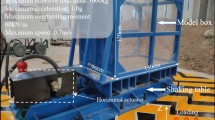Abstract
The performance-based liquefaction potential analysis was carried out in the present study to estimate the liquefaction return period for Bangalore, India, through a probabilistic approach. In this approach, the entire range of peak ground acceleration (PGA) and earthquake magnitudes was used in the evaluation of liquefaction return period. The seismic hazard analysis for the study area was done using probabilistic approach to evaluate the peak horizontal acceleration at bed rock level. Based on the results of the multichannel analysis of surface wave, it was found that the study area belonged to site class D. The PGA values for the study area were evaluated for site class D by considering the local site effects. The soil resistance for the study area was characterized using the standard penetration test (SPT) values obtained from 450 boreholes. These SPT data along with the PGA values obtained from the probabilistic seismic hazard analysis were used to evaluate the liquefaction return period for the study area. The contour plot showing the spatial variation of factor of safety against liquefaction and the corrected SPT values required for preventing liquefaction for a return period of 475 years at depths of 3 and 6 m are presented in this paper. The entire process of liquefaction potential evaluation, starting from collection of earthquake data, identifying the seismic sources, evaluation of seismic hazard and the assessment of liquefaction return period were carried out, and the entire analysis was done based on the probabilistic approach.











Similar content being viewed by others
References
Anbazhagan P, Sitharam TG (2008a) Seismic microzonation of Bangalore. J Earth Syst Sci 117(S2):833–852
Anbazhagan P, Sitharam TG (2008b) Mapping of average shear wave velocity for Bangalore region: a case study. J Environ Eng Geophys 13(2):69–84
Anbazhagan P, Vinod JS, Sitharam TG (2009) Probabilistic seismic hazard analysis for Bangalore. Nat Hazards 8:145–166
Cetin KO, Seed RB (2004) Non linear shear mass participation factor (rd) for cyclic shear stress ratio evaluation. Soil Dyn Earthq Eng 24(2004):103–113
Cetin KO, Der Kiureghian A, Seed RB (2002) Probabilistic models for the initiation of soil liquefaction. Struct Saf 24:67–82
Cetin KO, Seed RB, Kiureghian DA, Tokimastu K, Harder LF, Kayen RE, Moss RES (2004) Standard penetration test-based probabilistic and deterministic assessment of seismic soil liquefaction potential. J Geotech Geoenviron Eng 130(12):1314–1340
Cornell CA (1968) Engineering seismic risk analysis. Bull Seismol Soc Am 58:1583–1606
Cornell CA, Van Marke EH (1969) The major influences on seismic risk. Proceedings of the third world conference on earthquake engineering, Santiago, Chile, vol A-1, pp 69–93
Gutenberg B, Richter CF (1944) Frequency of earthquakes in California. Bull Seismol Soc Am 34:185–188
IS 1893(Part I) (2002) Indian standard criteria for earthquake resistant design of structures, part 1—general provisions and buildings. Bureau of Indian Standards, New Delhi
Iyengar RN, Ghosh S (2004) Microzonation of earthquake hazard in greater Delhi area. Curr Sci 87:1193–1202
Kayen RE, Mitchell JK, Seed RB, Lodge A, Nishio S, Coutinho R (1992) Evaluation of SPT, CPT, and shear wave-based methods for liquefaction potential assessment using Loma Prieta data. Proceedings of the 4th Japan–US workshop on earthquake-resistant design of lifeline facilities and countermeasures for soil liquefaction, vol 1, pp 177–204
Kiureghian DA, Ang AHS (1977) A fault-rupture model for seismic risk analysis. Bull Seismol Soc Am 67(4):1173–1194
Kramer S, Mayfield RT (2007) Return period of soil liquefaction. J Geotech Geoenviron Eng 133(7):802–813
National Center for Earthquake Engineering Research (1997) Proceedings of the NCEER workshop on evaluation of liquefaction resistance of soils. In: Youd TL, Idriss IM (eds) Technical Report No. NCEER, 97-022, NCEER, Buffalo, NY
RaghuKanth STG, Iyengar RN (2006) Seismic hazard estimation for Mumbai city. Curr Sci 91(11):1486–1494
RaghuKanth STG, Iyengar RN (2007) Estimation of seismic spectral acceleration in peninsular India. J Earth Syst Sci 116(3):199–214
Seed HB, Idriss IM (1971) Simplified procedure for evaluating soil liquefaction potential. J Soil Mech Found Eng 97:1249–1273
Seed HB, Tokimatsu K, Harder LF, Chung RM (1985) Influence of SPT procedures in soil liquefaction resistance evaluations. J Geotech Eng 111(12):1425–1445
Sitharam TG, Anbazhagan P (2007) Seismic hazard analysis for the Bangalore region. Nat Hazards 40:261–278
Sitharam TG, Anbazhagan P, Ganesha Raj K (2006) Use of remote sensing and seismotectonic parameters for seismic hazard analysis of Bangalore. Nat Hazards Earth Syst Sci 6:927–939
Sitharam TG, Anbazhagan P, Mahesh GU (2007) 3-D subsurface modeling and preliminary liquefaction hazard mapping of Bangalore city using SPT data and GIS. Indian Geotech J 37(3):210–226
Vipin KS, Anbazhagan P, Sitharam TG (2009) Estimation of peak ground acceleration and spectral acceleration for South India with local site effects: probabilistic approach. Nat Hazards Earth Syst Sci 9:865–878
Youd TL, Idriss IM, Andrus RD, Arango I, Castro G, Christian JT, Dobry R, Finn WDL, Harder LF Jr, Hynes ME, Ishihara K, Koester JP, Liao SSC, Marcuson III, Martin GR, Mitchell JK, Moriwaki Y, Power MS, Robertson PK, Seed RB, Stokoe KH (2001) Liquefaction resistance of soils: summary report from the 1996 NCEER and 1998 NCEER/NSF workshops on evaluation of liquefaction resistance of soils. J Geotech Geoenviron Eng 127:817–833
Acknowledgments
Authors thank ISRO-IISc Space Technology Cell, Indian Institute of Science, Bangalore, India for funding the project titled “Assessment of Seismicity of Peninsular India—Using Remote Sensing and GIS” (Ref. No. ISTC/CCE/TGS/195 Dated 7 March 2007).
Author information
Authors and Affiliations
Corresponding author
Rights and permissions
About this article
Cite this article
Vipin, K.S., Sitharam, T.G. & Anbazhagan, P. Probabilistic evaluation of seismic soil liquefaction potential based on SPT data. Nat Hazards 53, 547–560 (2010). https://doi.org/10.1007/s11069-009-9447-3
Received:
Accepted:
Published:
Issue Date:
DOI: https://doi.org/10.1007/s11069-009-9447-3




